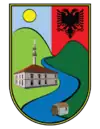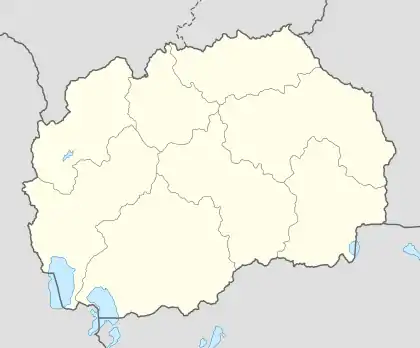Čegrane
Čegrane (Macedonian: Чегране; Albanian: Çegran) is a village in the municipality of Gostivar, North Macedonia. The village lies approximately 7 kilometres (4.3 mi) east of the city of Gostivar. It has a population of over 6,000 inhabitants. Prior to merging with Gostivar Municipality, Čegrane was the seat of Čegrane Municipality.
Čegrane
Чегране Çegran | |
|---|---|
Village | |
 Entrance to Čegrane | |
 Coat of arms | |
 Čegrane Location within North Macedonia | |
| Coordinates: 41°50′20″N 20°58′32″E | |
| Country | |
| Region | |
| Municipality | |
| Population (2002) | |
| • Total | 6,748 |
| Time zone | UTC+1 (CET) |
| • Summer (DST) | UTC+2 (CEST) |
| Postal code | 1237 |
| Area code(s) | +389 |
| Car plates | GV |
History

At the beginning of the 19th century Čegrane was a predominantly Albanian village in Tetovo's Gostivarska Nahiya of the Ottoman Empire. According to the statistics of Vasil Kanchov (Macedonia. Ethnography and statistics), in 1900, Čegrane had 800 Muslim Albanian inhabitants.[1] In 1913, the village came under the control of the Kingdom of Serbia along with the rest of Macedonia. According to the Russian Slavist Afanasij Selishchev in 1929, Čegrane was the center of municipality of five villages.[2]
Kosovo conflict (1999): Refugee camp
During the Kosovo War, a massive makeshift camp was set up for ethnic Albanian refugees in Čegrane by the United Nations High Commissioner for Refugees, International Federation of Red Cross and Red Crescent Societies and local NGOs. The area had been used as a rubbish dump, but the tiers that had cut into the steep hillside were filled with rows of thousands of tents.[3] It was managed by CARE, which initially expected 3,000 refugees.[4] It was filled to capacity in a matter of days.[5] It became the largest single camp in the entire crisis, housing over 43,000 people.[6] First hand reports describe that the Čegrane camp "held 57,000 displaced and emotionally shattered people."[3] They were provided with some humanitarian care, until safe passage was available back to Kosovo.
Demographics
According to Selishchev, the village had 234 houses with 1,364 Albanian inhabitants Albanians in 1929. According to the 2002 census, the village had a total of 6748 inhabitants.[7] Ethnic groups in the village include:[7]
- Albanians 6672
- Macedonians 2
- Bosniaks 1
- Others 73
Sports
The local football club KF Arsimi plays in the Macedonian Third Football League.
References
- Кѫнчовъ, Василъ. Македония. Етнография и статистика. София, Българското книжовно дружество, 1900. ISBN 954430424X. с. 214.
- Афанасий Селищев. „Полог и его болгарское население. Исторические, этнографические и диалектологические очерки северо-западной Македонии“. – София, 1929, стр. 26.
- Pascar, Jacqueline (2011). Abducted: The Fourteen-Year Fight to Find My Children. Random House. ISBN 9781845969653. Retrieved 1 April 2013.
- "CARE manages second refugee camp in Macedonia" (Press release). CARE. 26 April 1999. Retrieved 1 April 2013.
- Yearbook of the United Nations 1999, 53, United Nations Publications, 2003, p. 346, ISBN 9789211008562, retrieved 1 April 2013
- Pettifer, James; Vickers, Miranda (2007). The Albanian question: reshaping the Balkans. I.B. Tauris. p. 224. ISBN 9781860649745. Retrieved 1 April 2013.
- Macedonian Census (2002), Book 5 - Total population according to the Ethnic Affiliation, Mother Tongue and Religion, The State Statistical Office, Skopje, 2002, p. 191.